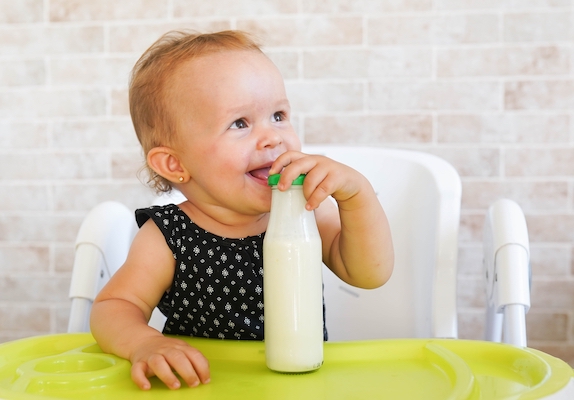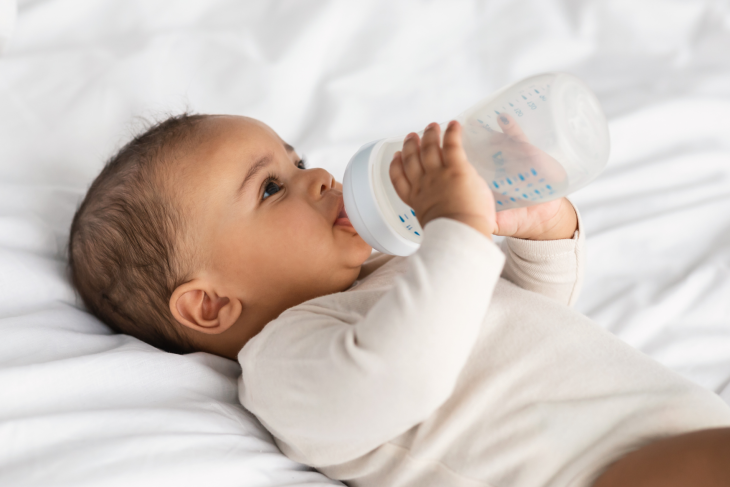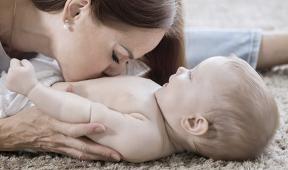4 tips to help you recognise regurgitation… And alleviate it!
Overview
Here are our tips to help you recognise the problem, prevent it and alleviate it as much as possible!
1. How do you recognise it?
Regurgitation occurs just after a feed (it will look like the milk the baby just drank) or after digestion has started (it will look like clotted milk and have a sour smell). The milk your baby has just swallowed comes back up in the opposite direction, from the stomach to the mouth (and the bib), mixed with gastric juices. Sometimes you may not even see anything coming out of his mouth but just see your baby chewing. But if he doesn't cry and is continuing to gain weight, there’s no need to worry! Everything will sort itself out as your baby grows. However, if you have the impression that it is painful for baby, or that the regurgitation is really too abundant, don’t hesitate to consult your doctor. The problem may be gastroesophageal reflux or GOR, which can eventually lead to oesophagitis (inflammation of the oesophagus). This should not be confused with vomiting, which is accompanied by muscle or abdominal contractions.
2. Good feeding habits
Take breaks during feeds. Take your time! So during feeds, whether you are breastfeeding or bottle-feeding, remember to take short breaks to allow your baby to burp before starting again. That will let your baby release any air she has swallowed. Also remember to tilt the bottle to prevent your baby swallowing too much air.
Favour an upright position: Hold or place your baby upright while feeding and then keep her in the same position for a few minutes. To limit the pressure on her little stomach, don't put your baby in a high chair until she can sit up by herself (usually at around 6 months of age).
Don’t forget to wind your baby: To avoid regurgitation, baby should burp after a feed and possibly during it when you take breaks.
Don’t put your baby to bed immediately after a feed: Wait at least 30 minutes. You can put him in a baby chair or raise the bed a little so that it is tilted. He should lie on his back with the head of the bed raised 10 to 15° to prevent regurgitation. Cot wedges exist to help.
In general, avoid putting pressure on your baby’s tummy with a nappy or clothes that are too tight, for example.
3. Choose your bottle carefully
If your baby suffers from regurgitation, there are special bottles to making feeds easier. Pay particular attention to the choice of teat!
- It must not allow too much air to pass through, because if baby swallows too much air during a feed, he will burp to evacuate it and will be more likely to regurgitate.
- In terms of flow, this should be neither too high so that baby does not swallow too quickly, nor too low so that he does not get frustrated.
- And choose one that can be used for thickened and/or anti-regurgitation formulas.

4. Choosing your baby’s milk
Breast milk remains the ideal nutrition for infants and the World Health Organisation (WHO) recommends that babies should be exclusively breastfed up until the age of 6 months.
But for babies who suffer from severe or persistent regurgitation, specific formulas exist: these AR* (Anti-Regurgitation/Anti-Reflux) formulas are designed to thicken the food bolus in your baby’s stomach. When the formula is thickened, it is difficult for the food bolus to travel back up to the mouth, and reflux is reduced. Two types of thickeners are authorised in formulas: starch and locust bean gum.
Important: if in doubt, don't hesitate to seek advice from your paediatrician, who will guide you towards the best formula and help you make the transition from a normal milk to an anti-regurgitation milk if necessary.
It will be easy for you to see if the milk you've chosen is effective: if your baby takes his bottle and regurgitates less or not at all, and he continues to gain weight, that means the formula suits him and you've made the right choice.
* Anti-Regurgitation/Anti-Reflux formulas should be used under medical supervision.

